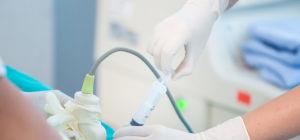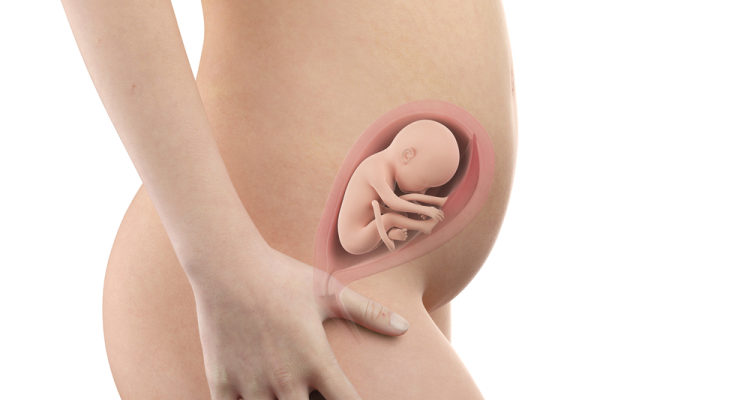Pregnant women aged 35 and over are at higher risk of having fertility problems. The prenatal screening test is now considered the best way to help eliminate any worries about this problem.
With the advancement of science and technology today, prenatal screening tests are becoming more popular and effective, especially for pregnant women aged 35 and older. So what are the benefits of fertility testing for women? With aFamilyToday Health learn through the following article.
When should pregnant women have prenatal screening?
1. What is the difference between prenatal screening and genetic diagnostic testing?
The prenatal screening test for a pregnant woman is a test done by analyzing a sample from blood or tissue. This test will let you know if you, your husband or your baby is carrying a gene that is causing the genetic abnormality in the fetus.
Genetic testing is a test method that uses a medical instrument to take a sample of tissue from the placenta (placenta) or a little amniotic fluid for analysis. Hence, this test is of pregnancy-invasive nature.
2. Why do pregnant women need prenatal screening?
If you have one of the following factors, you should have a pregnancy screening test:
Your spouse wants to have a baby, a close relative of you or your husband has a genetic disease.
You have had a child with a disability. Not all babies born with disabilities are due to genetic factors. A baby with a disability can be caused by chemicals, infection or physical trauma before birth. Sometimes, a baby is born with a disability for which doctors cannot find out the cause.
You have had many miscarriages. This is because some chromosomal abnormalities in the fetus can cause a miscarriage. Repeated miscarriages can lead to genetic disorders.
You used to have a baby, but the baby died and had signs related to genetic disorders.
You are over 35 years old. The likelihood of having a baby with chromosomal abnormalities increases with the age of the mother.
You have had a diagnostic screening test and the test results show that there are genetic abnormalities, your doctor will order you to do genetic diagnostic test to get the most accurate diagnosis of your pregnancy children.
What is the difference between prenatal screening and prenatal genetic diagnostic test?
Many people mistakenly believe that prenatal screening and genetic diagnostic testing are just one and the difference is in the name. In fact, if you look, you will find that the prenatal screening tests and genetic diagnostic tests are completely different. The prenatal screening test is done by either an ultrasound, a blood test, or both. A genetic diagnostic test is an invasive test of pregnancy through the use of a medical instrument that takes a sample of tissue from the placenta or a small amount of amniotic fluid for analysis.
The advantage of prenatal screening tests is that they are noninvasive so there is no risk of miscarriage and provide predictive information that the fetus will be born with a disability. The limitation of screening tests is the inability to answer whether or not the fetus is at risk for birth defects. In addition, screening tests provide information only about certain disorders. Therefore, screening tests are performed to predict a possible risk of a malformation, but not make an accurate diagnosis. In genetic counseling and prenatal screening, doctors often appoint pregnant women as screening tests to determine if they should have genetic testing.
The advantage of genetic diagnostic tests is that they will almost accurately diagnose the fetal abnormality. In other words, this prenatal screening test can give a clear answer whether or not the fetus has a genetic abnormality. The disadvantage of this form of prenatal screening is that it invades the pregnancy, so it can cause miscarriage, although there are no studies to confirm this problem.
Advantages of prenatal screening in the first 3 months of pregnancy
Screening tests in the first trimester tell you if your baby has chromosomal abnormalities early in pregnancy. The advantage of this method is that there is no risk of miscarriage compared to performing invasive tests such as a placenta biopsy (Chorionic Villus Sampling (CVS) or amniocentesis).
If the risk of the baby having an abnormality is low, the test results will give you peace of mind. In the case of a high-risk fetus, your doctor may consider having a biopsy of the placenta. The results of the placenta biopsy will show if there is a problem with the pregnancy when you are just pregnant in the first trimester. So it's best to have screening tests done in your first trimester as soon as possible. For some reason you don't want to have these screening tests, you can wait and have an amniocentesis in your second trimester.
Genetic tests, prenatal screening tests
1. Pregnancy ultrasound

An ultrasound scan of women of all ages is usually given at least once during pregnancy. During an ultrasound, the doctor will use high frequency sound waves to recreate the image of the fetus. Pregnancy ultrasound has the following effects:
Correctly diagnose that you are pregnant
Locate fetal heart
Determine the number of pregnancies in the uterus
Estimate the due date and monitor your baby's development
Determine the sex of the fetus
Determine the location of the placenta and the amount of amniotic fluid
Measure the nape of the nape of the neck when you are 11 weeks - 13 weeks, 6 days pregnant to predict the risk of your baby having Down syndrome (trisomy 21).
Identify signs of birth defects such as cleft palate, congenital heart , spina bifida, Down syndrome.
2. Double test, screening for the first trimester
This test is done between 11-14 weeks of pregnancy. The doctor will take blood for testing and an ultrasound.
A blood test will track two types of markers (markers) in the mother's blood
Ultrasound will evaluate the nape of the baby's nape.
From the information on these two screening methods, your doctor can find your baby's chromosome problems like Down syndrome. This test has the same role as triple test but allows the doctor to see the fetus. However, sometimes Double test also gives inaccurate results.
To get more accurate results than just doing a single test, you need to combine it with another blood test, for example triple test .
3. Triple test screening test (Quad marker Screening)
Triple test is a blood test done between 15 and 20 weeks of pregnancy. This test will evaluate the types of markers present in the blood, thereby diagnosing:
Problems with the baby's brain and spinal cord, called neural tube defects. These include spina bifida and anencephaly. Triple tests can identify about 75 to 80% of neural tube defects
Genetic disorders such as Down syndrome . This test can detect about 75% of fetal cases of women under 35 years old and more than 80% of fetuses of women 35 years of age and older have this syndrome.
It is important to know that triple test only shows the risk of birth defects for your baby. If the test shows that the fetus is at risk, it is called positive. As mentioned above, this test is only predictive so even if the test is positive does not mean your baby will definitely have a birth defect. Therefore, in some cases, the baby is still born healthy, even though the screening test is abnormal.
If the test is positive, your doctor may suggest additional diagnostic tests, such as:
Amniocentesis to check the fetal chromosomes
Ultrasound to look for signs of birth defects.
4. Amniocentesis
Unlike an ultrasound or a blood test, which only gives an estimate of what a baby is at risk, amniocentesis is a type of prenatal screening test used to make a diagnosis. When done, the doctor will insert the needle through the abdominal wall under the guidance of the ultrasound device into the mother's uterus. The needle will help the doctor remove a small amount of amniotic fluid from the amniotic sac and then have it tested for manifestations of a genetic disease. In addition to common chromosomal problems including Down syndrome, Edwards (trisomy 18), Patau (trisomy 13) and Turner syndrome, this test can also show:
Sickle cell disease
Cystic fibrosis
Muscular dystrophy
Tay-Sachs Disease
Neural tube defects such as spina bifida and brainlessness.
When you've finished your amniocentesis, always want to know how long it will take for the amniocentesis to be available? Unlike ultrasound, because the amniotic cells have to be cultured and the chromosomes of the cells have to be cultured after culture, it takes about 2-3 weeks for you to get the results.
5. Test for placenta biopsy (Chorionic Villus Sampling - CVS)

Placenta biopsy is an alternative test for amniocentesis and may be done earlier in pregnancy than amniocentesis. Like amniocentesis, placenta biopsy can diagnose many diseases. If you have significant risk factors, you may be offered a spiked biopsy to identify birth defects early in pregnancy.
During the procedure, the doctor removes a small sample of cells from the placenta, called the placenta. The spines are small parts of the placenta made up of fertilized egg cells that share the same genome as the fetus. To get those cells, the doctor inserts a needle through the vagina or abdominal wall depending on where the placenta is. The cells are then tested to identify the fetal chromosome, similar to amniocentesis.
Placenta biopsy and amniocentesis are often associated with genetics. So these tests help you to know the risk of fetal genetic diseases. At the same time, the genetic counselor will tell you about the pros and cons of the above measures before proceeding.
6. Non-invasive prenatal tests
A new type of blood test called a DNA test that collects free DNA of the fetus in mother's blood will show if the fetus has chromosomal abnormalities. This method only needs to use a blood sample from the pregnant woman, so it does not cause invasive pregnancy such as amniocentesis or placenta biopsy.
This test is done from 10-22 weeks of pregnancy to find and filter the fetal DNA in the mother's blood. The results will determine the odds of a baby being born with Down syndrome, trisomy 18 or trisomy 13. This non-invasive prenatal diagnostic test can identify about 99% of cases of Down syndrome and trisomy 18, much better than other blood tests. Most cases of trisomy 13 can also be identified with this test.
If this test shows that the fetus is at high risk for chromosomal problems, your doctor will recommend a placenta biopsy or amniocentesis to confirm the diagnosis. Because this is a new type of test, it is likely that insurance will not cover the cost or many hospitals in our country perform. If you are interested, ask your doctor directly at the hospital for a full consultation.
Benefits of prenatal screening

Remember that most women between the ages of 35 and more or about to turn 40 if they are in good health can still conceive and have a healthy baby. However, these prenatal genetic screening tests will still be of great help during pregnancy:
You will know the health of your unborn baby
If any genetic problems are found, the doctor will take immediate action
The information from screening tests helps you to make decisions about the best method of pregnancy care.
Not all prenatal screening tests will give safe results or determine your baby is not at risk. Sometimes the test results are not really accurate. Therefore, you need to consult a specialist about the risks, benefits, and limitations that these tests bring to choose the method that is best for you.
Prenatal screening is an essential step in determining the risk of your baby being born without many genetic diseases that seriously affect the physical and mental health. You can refer to the above information to make the most suitable test selection.














